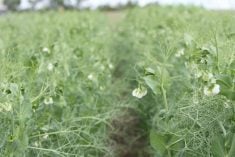Cattle prices static
Fed cattle prices changed little last week with averages up 75 cents
per hundredweight on steers and unchanged on heifers, mostly from a
quality perspective.
Volumes increased 18 percent to almost 19,000 head with more heifers
trading, said Canfax.
A lot of heavy cattle were in the mix. Buyers were not aggressive and
cattle were moved south as well as to western buyers.
Alberta prices Nov. 7 were steers $96.50-$99.50 per cwt., flat rail
Read Also

Prairies have variable soil moisture conditions
The dry weather in the west was welcome for preserving grain quality and advancing harvest, but it has resulted in very dry soil moisture conditions.
$160.75-$164.20 and heifers $96.50-$99.50, flat rail $160.75-$163.00.
With cattle prices subsiding from recent increases, wholesale beef
prices remained steady.
The Montreal price is steady to $1 per cwt. lower at $167.
Calgary is mostly steady with the bulk at $153-$157 and tops to $163
cwt.
Canfax said movement was adequate for this time of year, but expected
to slow later this month.
Feeder market slow
Climbing carcass weights confirm that cattle feeders have not been
active sellers.
High break-evens and expectations for higher fed cattle prices through
November have sellers dragging their feet.
Although the market is expected to trend higher, delayed selling and
resulting higher weights could delay price increases.
Producers need to keep selling on schedule, said Canfax.
Feeder cattle prices were mixed. Steers traded mostly steady at $2 per
cwt. lower.
Most heifer classes were steady to $3 per cwt. lower, however 400-500
lb. heifers gained $1 per cwt.
Volumes were slightly smaller at 112,700 head, but 30 percent larger
than the same week last year.
More yearlings were in the mix and the increase in numbers, as well as
quality, likely caused the lower prices.
Slaughter cow prices were under pressure most of the week due to
increased numbers at auction. Also, there are reports of transportation
problems.
Overall, prices were only $2 per cwt. lower than the previous week, but
by the end of last week, the average would have been lower again.
Calves in demand
Yearlings and top quality calves are still at a premium and will likely
continue strong. Continued interest from the U.S. will support the
bottom of the market.
Bred replacement cow and heifer prices were little changed. Cows traded
at $550-$1,200 and heifers were $600-$1,200.
The bulk of all the bred stock traded at $700-$1,100.
Cattle on feed
The number of cattle on feed in Alberta and Saskatchewan as of
Nov. 1 was down by 25 percent from last November to 857,056 head.
Placements into feedlots in October were down 16 percent from last year.
Strong feeder exports and a lack of imports in October left Western
Canada with about 120,000 fewer feeders available to place than last
year.
The number of cattle marketed in October was down six percent from last
year to 237,436 head.
Weekly hog kill up
Wholesale U.S. pork prices were volatile. The pork cut-out value rose
by close to $2 US per cwt. from Nov. 1 to Nov. 6, but decreased on Nov.
7.
Packers slaughtered large numbers of hogs. Although daily kills were
down slightly from the previous week, the weekly kill could be about
four percent above last year.
The Iowa-Minnesota daily direct hog price (plant mean, 51-52 percent,
lean carcass converted to live weight) rose from $29.76 per cwt. on
Nov. 4 to $31.52 on Nov. 7.
On average, the U.S. hog price was about eight to nine percent above
the previous week’s price.
Lean hog futures prices rose again last week.
A look at hog slaughter and weights in September and October helped
explain the volatility of this autumn’s market, said Manitoba
Agriculture.
U.S. hog slaughter in September was nine percent above September 2001.
However, this large increase was moderated slightly by a one-pound
decrease in average carcass weights so that pork production was up by
eight percent from the previous year to 1.64 billion lb., a monthly
record high.
In October, similar hog slaughter to a year earlier combined with a
three-pound drop in carcass weights resulted in pork production of
less than 1.82 million lb, a decline of 1.3 percent from the previous
October.
Manitoba plants slaughtered close to 97,000 head two weeks ago ,
which, if continued, could raise projected 2002 hog slaughter in the
province by six percent to about 4.4 million head.














